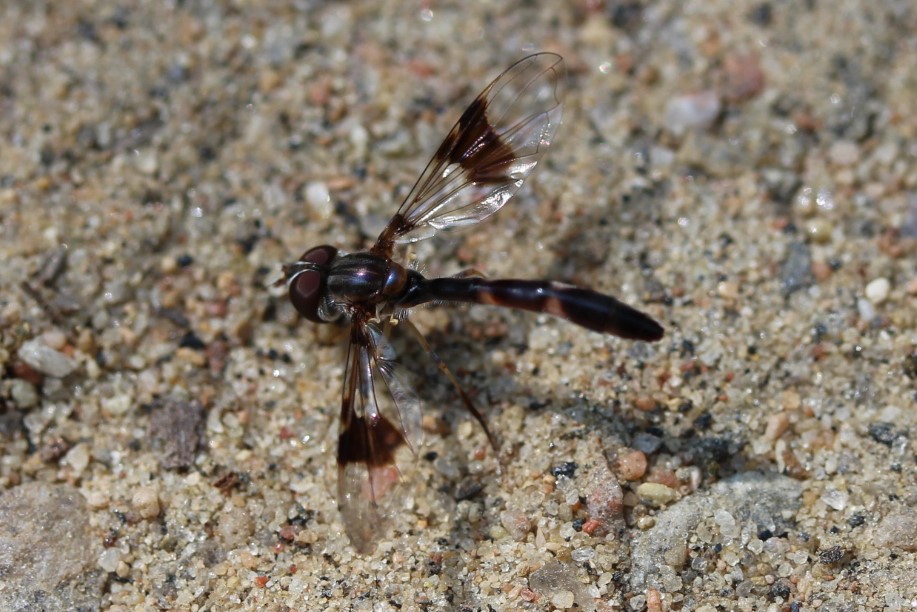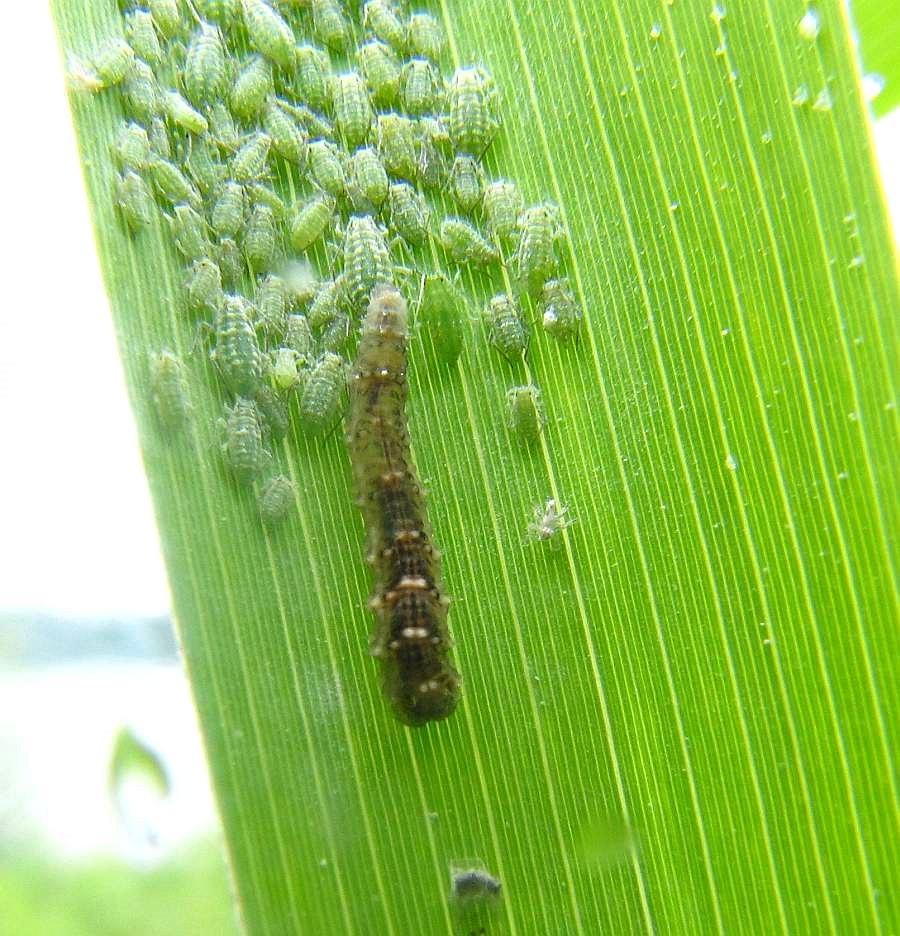Ocyptamus fascipennis

When you’re interested in insects, you’re always going to be running into something new. There is always one more creature that you have never seen before, one more behaviour you haven’t heard of, and that’s because insects are incredibly diverse. Today, I’m going to pick out just one of the many species of insects to zoom in on, and explore its story.
The species I’ve chosen is Ocyptamus fascipennis, or the Eastern Band-winged Hover fly. Let’s start from the top: Ocyptamus fascipennis is a “True Fly”, a member of the Order Diptera, which is a division of the Class Insecta. Diptera means “two wings” which gives you the easiest way to identify this group of insects when you encounter them. Almost all insect groups have 4 wings (two pairs) but these pairs of wings have been modified into very different structures in different lineages of insects. For the True Flies, one pair of wings still provides lift and flight, while the other has been reduced into tiny knobs known as halters. These reduced wings act as stabilizers, giving the flies the ability to perform aerobatic feats of agility (as I’m sure we’re all familiar with in House Flies (Musca domestica)). The halters of Diptera are more than just balancing beams, they’re actually sending complicated signals to the fly about its aerial position.
Ocyptamus fascipennis is part of a Family of True Flies called Hover Flies, or Flower Flies (Family Syrphidae). The Syrphids are common insects in gardens where they feed on nectar and pollinate flowers. Because of this habit, many species of Syrphids have taken on the appearance of more conspicuous flower visitors such as bees and wasps, in order to gain some protection from the classic warning colours of black-and-yellow stripes. O. fascipennis in particular seems to mimic solitary wasps or types of parasitoid wasps with its elongated and narrow abdomen.
So far, we’ve been talking about adults of these flies, but all insects go through multiple life stages, some more dramatically varied than others. Diptera undergo holometabolous growth which is a fancy way of saying that they have life stages that look very different from each other and one of those stages is a transformation phase which is mostly immobile. When young hoverflies (larvae) hatch from eggs, they look very different from the adults landing and lifting from flower petals in gardens. Larval O. fascipennis have no wings, and no legs, and are sometimes known by the name that many fly larvae receive: maggots. O. fascipennis larvae don’t consume garbage or dead animals, but instead are active predators, squirming across leaves in search of their prey: aphids.
Stephen Marshall, in his incredible book about Insects describes Syrphine larvae hunting as this: “at night they move blindly among the aphids, grasping victims using typical maggot mouth hooks, then holding the doomed aphids up off the surface to consume the body contents.” (Marshall, 2006).

It seems then that Flower Flies are very beneficial insects to have in the garden. They provide pollination for flowers, and their larvae consume plant-eaters such as aphids and related scale insects.
While I was unable to find very much information pertaining to Ocyptamus fascipennis specifically, one other member of the genus deserves special mention because of its interesting larval habitat: tank plants (Bromeliaceae). The Central American and South American species of Ocyptamus that inhabit these confined aquatic habitats (pools of water within the plant itself) ambush and consume other aquatic insect larvae that live in the plants alongside them. The larvae are even thought to use a paralyzing venom to subdue their prey (Rotheray et al, 2000).
All in all, Ocyptamus fascipennis and its relatives are fascinating flower flies with intriguing habits. I hope you’ve enjoyed taking a closer look at them today.
UPDATE NOVEMBER 2021: Near Point Pelee, Ontario, individuals of Ocyptamus fascipennis were observed apparently migrating. The flies were observed moving East to West along with several other insects including tens of thousands of potter wasps (Ancistrocerus adiabatus) (Skevington and Buck 2021). The authors of the paper note that insect migration is a largely understudied phenomenon, especially in North America, so further study is needed to figure out the details.
References:
Rotheray, G. E., M. Zumbado, E. G. Hancock and F. C. Thompson. 2000. “Remarkable aquatic predators in the genus Ocyptamus (Diptera, Syrphidae).” Studia Dipterolologica 7: 385-98. (full text available here: https://repository.si.edu/bitstream/handle/10088/17095/ent_FCT_89.pdf?sequence=1&isAllowed=y )
Marshall, Stephen. Insects: Their Natural History and Diversity. 2006.
Marshall, Stephen. Flies: The Natural History and Diversity of Diptera. 2010.
Skevington, Jeffrey H., and Buck, Matthias. 2021. “The first documented migration of a potter wasp, Ancistrocerus adiabatus (Hymenoptera: Vespidae: Eumeninae)”. Canadian Field-Naturalist 135 (2): 117-119.
4 replies on “Eastern Band-winged Hover Fly”
[…] done a few “Species Profiles” in the past (the Introduced Pine Sawfly and the Eastern Band-Winged Hoverfly), and in those I’ve offered a brief overview of the groups those species belong to before […]
LikeLike
[…] –Species Profile: Eastern Band-winged Hover Fly […]
LikeLike
[…] welcome post): the Eastern Band-winged Hover Fly (Ocyptamus fascipennis). I have added an update to this post to reflect this recent interesting note about this species (spoiler alert: it’s possibly […]
LikeLike
[…] –Eastern Band-winged Hover Fly […]
LikeLike